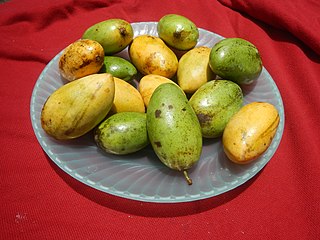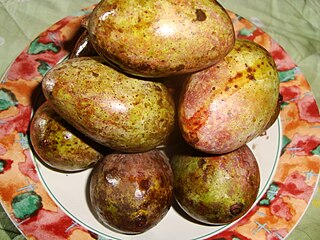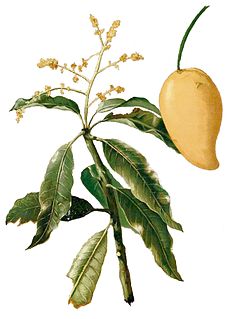
Mangifera is a genus of flowering plants in the cashew family, Anacardiaceae. It contains approximately 69 species, with the best-known being the Common Mango. The center of diversity of the genus is in the Malesian ecoregion of Southeast Asia; particularly in Sumatra, Borneo, and the Malay peninsula. They are generally canopy trees in lowland rainforests, reaching a height of 30–40 m (98–131 ft).

Mangifera altissima, is a species of mango native to the Philippines and surrounding regions in Indonesia, Malaysia, Papua New Guinea and the Solomon Islands. It is not grown commercially but is harvested from the wild in the Philippines. It has small fruits that are pale yellow when ripe and are very sweet, though much more fibrous than commercially cultivated Mangifera indica species like Carabao mangoes. It is threatened by habitat loss.

Mangifera andamanica belongs to the family Anacardiaceae and is endemic to the Andaman Islands in the Bay of Bengal. The fruits are edible and smaller than the Common Mango. This species is conserved at the Field Gene bank of Jawaharlal Neheru Tropical Botanic Garden and research Institute, Thiruvananthapuram, India.
Mangifera austro-indica is a species of plant in the family Anacardiaceae. It is native to Karnataka and Tamil Nadu in India.

Mangifera casturi is a species of plant in the family Anacardiaceae.
Mangifera collina is a species of plant in the family Anacardiaceae. It is endemic to an area near Chiang Mai, Thailand.
Mangifera dongnaiensis is a species of plant in the family Anacardiaceae. It is an endangered endemic tree found in Vietnam, where it is called xoài rừng.

Mangifera foetida is a species of plant in the family Anacardiaceae. It is found in wet-land rainforest regions of Indonesia, Malaysia, Myanmar, Singapore, Thailand, and Vietnam.
Mangifera magnifica is a species of tree in the family Anacardiaceae. Its common name is Machang Pulasan.
Mangifera minutifolia is a species of plant in the family Anacardiaceae. It is endemic to Vietnam.
Mangifera nicobarica is a species of plant in the family Anacardiaceae. It is endemic to the Nicobar Islands.

Mangifera pajang is a species of tree in the family Anacardiaceae. It is endemic to Borneo, where it is known by the native name Bambangan.
Mangifera parvifolia is a species of plant in the family Anacardiaceae. It is a tree found in Indonesia, Malaysia, and Singapore.
Mangifera pentandra is a species of plant in the family Anacardiaceae. It is found in Malaysia, Singapore, and possibly Thailand.
Mangifera rubropetala was a species of plant in the family Anacardiaceae. It was found in possibly Indonesia and Malaysia.

Mangifera sylvatica, also known as the Himalayan mango, pickling mango, or Nepal mango, is a species of plant in the family Anacardiaceae. It is found in Bangladesh, Cambodia, China (Yunnan), India, Myanmar, Nepal, Bhutan and Thailand. It is a tree 6–20 m (20–66 ft) tall. The fruit measure 6 cm–8 cm × 4 cm–5 cm.
Mangifera taipa is a species of plant in the family Anacardiaceae. It is native to the Maluku Islands.

Mangifera indica, commonly known as mango, is a species of flowering plant in the sumac and poison ivy family Anacardiaceae. Mangoes are believed to have originated from the region between northwestern Myanmar, Bangladesh, and India. It is a large fruit-tree, capable of growing to a height and crown width of about 30 metres (100 ft) and trunk circumference of more than 3.7 metres (12 ft).

Mangifera gedebe is a species of plant in the family Anacardiaceae. In Javanese it is known as kedepir, in Malay repeh, in Sumatra it has been called gedepir, and in Kalimantan kepi. It is a tree, and can grow up to 30 metres tall and up to 60 centimetres diameter, though it usually grows to about 15 metres tall and 45 centimetres diameter at breast height. The elliptic to oblong-shaped leaves are somewhat leathery in texture and 5 to 23 cm in length and 2 to 6 cm in width. The flowers are white, and have five stamens, of which only one is fertile. It produces obliquely subrotund drupes as fruit, these are 8 to 9 cm in diameter and have a thin layer of fibrous flesh. The seeds, like a walnut, have a very irregularly lobed and folded surface.









